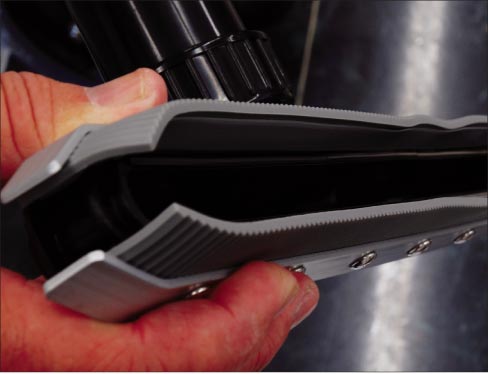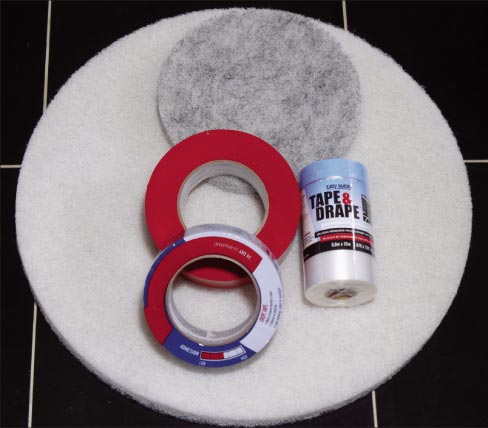Stone Restoration and Maintenance Corner: Preparing a Checklist for Your Crew
Bob Murrell
M3 Technologies
Photos provided by Bob Murrell
 |
|
A good visual inspection of your most-used equipment should be done before leaving the shop. This should become routine for you and your crew. No one wants to arrive at a distant jobsite and find out that a tool was put away defective or broken. |
 |
|
Maintaining a list of consumable supplies that you need on the jobsite, like pads, tape, drape cloth and chemicals, will save you time, money and stress. Additionally, all equipment should be inspected and checked for proper operation prior to leaving for the jobsite. Squeegees on wet vacs, weights for the machine, clean mop heads, Velcro drive plates (for both floor machines and hand tools) all should be in good working condition. |
Whether loading your van, trailer, truck, or a combination of these, your crew should develop a checklist of tools and products to have with them for all projects. It is better to have something and not need it than to need it and not have it. It is good protocol to physically check off the list on hard copy or smart device before departure.
Of course, some specific tools and products may be required for a particular project, on occasion. And there will always be that situation where you can’t find or forgot to bring a particular tool or product. If you are in a remote location, this can be become an expensive trip – not to mention the lost time involved. In many cases you will not be able to find industry-specific products locally, so you could be waiting for days and/or have to pay costly air freight charges, if this is even possible. Some products can’t be shipped air freight, such as some impregnators, adhesives, etc.
I have been supplying product and support to this industry for over 35 years, and believe me when I tell you that the calls I get all day long are for product needed yesterday. Don’t get me wrong, many contractors do try to anticipate and order for stock the consumables they use most frequently like 5X, XXX Shine, and Stone Polishing Compound. These products really have no shelf life, so they should be kept readily available.
Consumables like razor blades, Tape & Drape, blue tape, red tape, absorbent rags, contractor paper, etc., should also be readily available on the truck. Grout brushes, natural polishing pads, white pads, and maybe even a black stripping pad should also be included.
Items like small grout brushes (maybe even some old stiff tooth brushes), putty knives, buckets, water hoses, extension cords, and a good set of tools are essential items to have included on the truck and/or trailer.
Don’t forget the duct tape, Gorilla Glue, contact cement, and spray adhesive for Velcro repair among other issues. These items, along with mineral spirits, paint stripper, and other solvent-based products should not be left in the truck, trailer, or van, especially in the summer time. So, these items will need to be loaded each day and monitored to ensure no swelling or leaking occurs.
Contractor lights are also a must have on the truck. Projects can work into the night or are located in interior spaces which receive little to no natural light. Many times I have seen contractors leave at night thinking everything looked great only to receive a call in the morning that there are still issues remaining. That would be a real bummer for sure!
Air movers or fans are also good to have on hand as crystallizing or sealing/impregnating cannot be implemented until the surfaces are totally dry. Also when stone is wet, it can’t be effectively inspected for consistencies and profiles. Scratching can’t be seen when the tiles are wet.
All equipment should be inspected and checked for proper operation prior to leaving for the jobsite. Squeegees on wet vacs, weights for the machine, clean mop heads, Velcro drive plates (for both the floor machines and hand tools) all should be in good working condition. All electrical cords and plugs should be in good condition and meet code.
Diamonds, diamond impregnated pads, splash guard, honing powders, and any cleaning products should be neatly grouped for easy selection.
Of course, locations for water supply, breaker boxes, and dumping of effluent should all be previously agreed upon. Pathways in and out and any furniture or rug/mat removal should be on the checklist as well.
Before pictures and/or video should be taken prior to commencing project operations. Gloss meter readings should be taken, if required. Of course, final after pictures and readings are important to get once the job is satisfactorily completed.
Always leave a jobsite cleaner than when you arrived. This has been one of my biggest pet peeves for many years, and so I always recommend this to my contractor customers to check this off their final list. All protective poly and paper trash picked up, all surfaces buffed and clean, and no signs of the team having been present other than the positive outcome you’ve been contracted to provide.
Customers should be left with the proper maintenance products and instructions to care for their installations when finishing a project. Never leave it up to the customer to fend for themselves after you leave. It is unprofessional and could jeopardize your work as well as your reputation! If you are not the one who will be taking care of the ongoing maintenance, always leave the client with the proper instructions for them to be able to do so correctly. It is simply good business.
By no means have I covered all and every possible item on one’s checklist. I have merely attempted to stress how important it is to work with a checklist. It takes years to develop a complete list, and it should be ongoing and evolving.
On a personal note, the bees are buzzing as summer approaches. I saw many swarms this past spring season but so far have been unable to capture any. So, I continue to add honey supers (boxes for the bees to make extra honey in) and inspect for signs of healthy colonies.
As always, I have to close with the importance of partnering with a good distributor of quality products and technical support. It is essential for a contractor’s success.